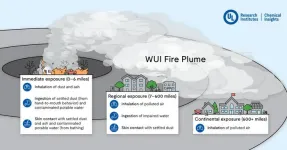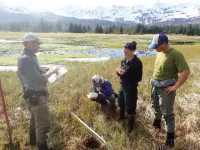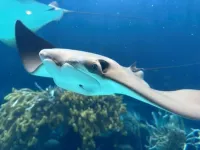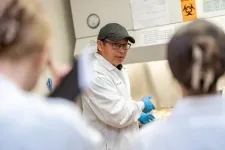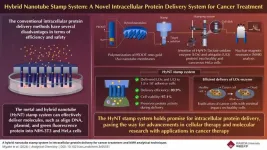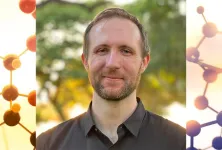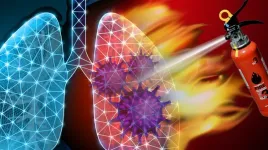(Press-News.org) ATLANTA - Chemical Insights Research Institute (CIRI) of UL Research Institutes applies cutting edge technologies to evaluate the toxicity of burn-impacted land areas affected by the August 2023 Lahaina wildfires. Created with CIRI research partners from Duke University and the East-West Center (EWC) in Hawai’i, the study known as Lahaina Environmental Assessment Project (LEAP), will collect and analyze residual dust, soil and ash samples from properties affected by the fires. These residues, including fine dust, can infiltrate schools, homes and office buildings and can also be recirculated into the air. Exposure may contribute to acute and chronic health concerns from inhalation of the dust or ingestion from frequent hand to mouth transfer. Residues may also contaminate the local ecosystem and wash into waterways.
CIRI is applying a combination of real-time and laboratory analytical chemistry techniques with high-resolution environmental sampling maps to determine the spatial relationships among the locations, types, and levels of volatile organic compounds (VOCs) and metals associated with fire residues. Samples from over 60 properties in the fire-affected areas are being collected for study. Information gained will contribute to scientific knowledge on health risks of toxic residues left in the aftermath of wildland urban interface (WUI) specific fires. Currently, there is little data on this topic, yet WUI fires are exponentially growing, adversely affecting local communities and extended regions.
“An understanding of these risks is critical to mitigating people exposure and developing community clean up and land reuse strategies,” said Dr. Marilyn Black, VP and Senior Technical Advisor for CIRI, who also co-authored the National Academy’s report titled, The Chemistry of Fires at the Wildland-Urban Interface. “CIRI’s scientific advances with the assistance of its research partners at Duke and EWC will help unravel the complexities of WUI fires, the fate of resulting contamination, and steps for protecting public health.”
“With more than 4,500 households displaced by the fires, the likely contamination of the soil, water, and air is also an important factor in the rebuilding process from a public health perspective,” according to Dr. Sumeet Saksena, Senior Fellow at the East-West Center. “We are working to identify sources on the properties that may have led to unique contamination when they burned, such as vehicles, solar panels, and home appliances.”
Analysis of the samples will be done in CIRI’s Center for Advanced Measurements in Marietta, Georgia. CIRI will use its newly developed environmental Dust VOC (DVOC)™ methodology to analyze a wide range of VOCs in one sample with detection in the parts-per-trillion level. Preliminary evaluations of Maui burn residue using CIRI’s methodology have identified over 500 different VOCs that can be assessed for health concerns. Preliminary analyses of the residue samples also found the presence of metals of concern including arsenic, lead, chromium and lithium.
CIRI’s research plan can be reviewed here.
About Chemical Insights Research Institute:
Chemical Insights Research Institute (CIRI) of UL Research Institutes is a nonprofit organization dedicated to scientific research, publication, education, and communication on environmental exposures resulting from technologies and practices, their impact on human health, and processes for reducing health risks. CIRI provides actionable data and resources to help manufacturers, educators, healthcare providers, and consumers make informed environmental health decisions and risk reduction strategies for the protection of human health.
About UL Research Institutes
UL Research Institutes is a nonprofit research organization dedicated to advancing public safety through scientific discovery. Since 1894, our research has advanced our mission toward a safer, more secure, and sustainable future. Focused on global risks from fire mitigation and air quality to safe energy storage and digital privacy, we conduct rigorous independent research, analyze safety data and partner with experts to uncover and act on existing and emerging risks to human safety.
About East-West Center
The East-West Center was established by the United States Congress in 1960 as a national educational institution to foster better relations and understanding among the peoples of the United States, Asia, and the Pacific islands through programs of cooperative study, training, and research.
About Duke University Exposure Biology and Chemistry (EBC) Lab
The Exposure Biology and Chemistry Laboratory at Duke University is located at the Nicholas School of the Environment Levine Science Research Center (LSRC) building and hosts 1,100 sq ft of wet laboratory space for the analysis of environmental and biological samples. EBC Lab, directed by Prof. Jim Zhang who is a collaborator on the LEAP study, develops novel biomarkers of environmental exposures and supports research that assesses pathophysiological changes caused by environmental exposures. Laboratory site: http://sites.globalhealth.duke.edu/ebclab.
Media Contacts:
Bert Kelly
Chemical Insights Research Institute
Bert.kelly@ul.org
Derek Ferrar
East-West Center
ferrard@eastwestcenter.org
END
Chemical Insights Research Institute partners with Duke University and the East-West Center to examine dust and ash from devastating Hawai’ian wildfires
2024-05-20
ELSE PRESS RELEASES FROM THIS DATE:
NCCN publishes new resource for patients with intestinal cancer type most have never heard of before diagnosis
2024-05-20
PLYMOUTH MEETING, PA [May 20, 2024] — The National Comprehensive Cancer Network® (NCCN®) today announced publication of new NCCN Guidelines for Patients®: Small Bowel Adenocarcinoma. This free resource for people facing cancer and caregivers is focused on a rare cancer type that typically occurs in the small intestine, where routine screening is impossible, even for high-risk individuals. The small amount of patient information that exists for this cancer type tends to combine it with other cancers of the small intestine (such as sarcomas, neuroendocrine tumors, or lymphomas) despite very different treatment approaches and results.
The NCCN Guidelines for Patients: ...
Subduction zone splay faults compound hazards of great earthquakes
2024-05-20
Groundbreaking research has provided new insight into the tectonic plate shifts that create some of the Earth’s largest earthquakes and tsunamis.
“This is the first study to employ coastal geology to reconstruct the rupture history of the splay fault system,” said Jessica DePaolis, postdoctoral fellow in Virginia Tech's Department of Geosciences. “These splay faults are closer to the coast, so these tsunamis will be faster to hit the coastline than a tsunami generated only from ...
Record low Antarctic sea ice ‘extremely unlikely’ without climate change
2024-05-20
In 2023, Antarctic sea ice reached historically low levels, with over 2 million square kilometres less ice than usual during winter – equivalent to about ten times the size of the UK. This drastic reduction followed decades of steady growth in sea ice up to 2015, making the sudden decline even more surprising.
Using a large climate dataset called CMIP6, BAS researchers investigated this unprecedented sea ice loss. They analysed data from 18 different climate models to understand the probability of such a significant reduction in sea ice and its connection to climate change.
Lead author Rachel Diamond explained that while 2023's extreme ...
After hundreds of years, study confirms Bermuda now home to cownose rays
2024-05-20
For hundreds of years, the whitespotted eagle ray (Aetobatus narinari) has been considered the only inshore stingray species in Bermuda, until now.
Using citizen science, photographs, on-water observations and the combination of morphological and genetic data, researchers from Florida Atlantic University’s Harbor Branch Oceanographic Institute and collaborators are the first to provide evidence that the Atlantic cownose ray (Rhinoptera bonasus) has recently made a new home in Bermuda.
Because ...
Scientists uncover promising treatment target for resistant brain cancer
2024-05-20
For many patients with a deadly type of brain cancer called glioblastoma, chemotherapy resistance is a big problem.
Current standard treatments, including surgery, radiation, and chemotherapy using the drug temozolomide, have limited effectiveness and have not significantly changed in the past five decades. Although temozolomide can initially slow tumor progression in some patients, typically the tumor cells rapidly become resistant to the drug.
But now, Virginia Tech researchers with the Fralin Biomedical Research Institute at VTC may ...
Revolutionizing cancer treatment by intracellular protein delivery using hybrid nanotubes
2024-05-20
In today's medical landscape, precision medicine and targeted therapies are gaining traction for their ability to tailor treatments to individual patients while minimizing adverse effects. Conventional methods, such as gene transfer techniques, show promise in delivering therapeutic genes directly to cells to address various diseases. However, these methods face significant drawbacks, hindering their efficacy and safety.
Intracellular protein delivery offers a promising approach for developing safer, more targeted, and effective therapies. By directly transferring proteins into target cells, this method circumvents issues such as silencing ...
Chemist Julian West makes C&EN magazine’s ‘Talented 12’ list
2024-05-20
HOUSTON – (May 20, 2024) – Rice University chemist Julian West is one of a dozen up-and-coming young scientists featured in Chemical & Engineering News’ (C&EN) 2024 Talented 12, an annual issue of the weekly news magazine that highlights rising stars across all chemistry research disciplines.
West, an assistant professor and the Norman Hackerman-Welch Young Investigator in Rice’s Department of Chemistry, is a synthetic chemist whose lab designs novel chemical reactions. Drawing inspiration from biology, West’s research group has found ways to simplify the production of entire libraries of feedstock chemicals ...
Robot-phobia could exasperate hotel, restaurant labor shortage
2024-05-20
VANCOUVER, Wash. – Using more robots to close labor gaps in the hospitality industry may backfire and cause more human workers to quit, according to a Washington State University study.
The study, involving more than 620 lodging and food service employees, found that “robot-phobia” – specifically the fear that robots and technology will take human jobs – increased workers’ job insecurity and stress, leading to greater intentions to leave their jobs. The impact was more pronounced with employees who had ...
Study offers new detail on how COVID-19 affects the lungs
2024-05-20
In some severe cases of COVID-19, the lungs undergo extreme damage, resulting in a range of life-threatening conditions like pneumonia, inflammation, and acute respiratory distress syndrome. The root cause of those wide-ranging reactions in the lungs has until now remained unclear.
A new study by researchers at Columbia and the Columbia University Irving Medical Center sheds light on this mystery. The study found that ferroptosis, a form of cell death first named and identified at Columbia in 2012, is the major cell death mechanism that underlies COVID-19 lung disease. The finding indicates that deliberately halting ...
Body’s ‘message in a bottle’ delivers targeted cancer treatment
2024-05-20
Researchers at Karolinska Institutet in Sweden have succeeded in delivering targeted cancer treatment via small membrane bubbles that our cells use to communicate. A new study published in Nature Biomedical Engineering shows that the treatment reduces tumour growth and improves survival in mice.
When our cells communicate, they send out small membrane bubbles known as extracellular vesicles which contain various signalling molecules. Interest in these tiny bubbles, sometimes referred to as the body’s ...
